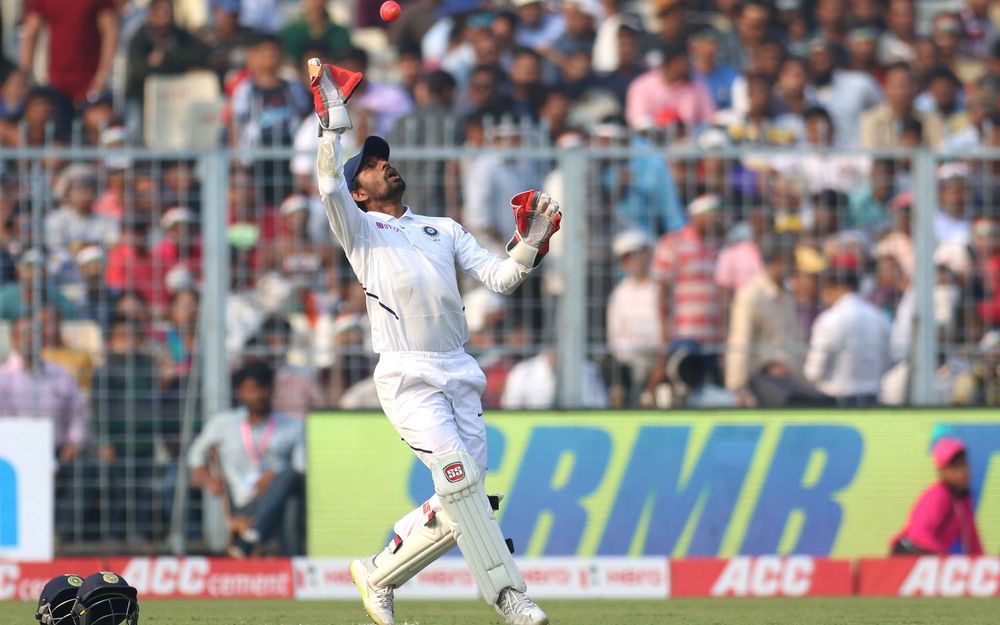IND vs BAN | Kolkata Day 1 Talking Points: India’s mantra in cracking pink ball code and deceiving pink cherry
When it comes to making history in Indian cricket, the Eden Gardens in Kolkata takes away the accolade. As the city turned pink to host the nation’s first-ever Day-Night Test, it was Wridhhiman Saha’s Superman-like keeping and the myriad characteristics of the pink ball that defined the highlights.

Wriddhiman Saha, the best wicketkeeper in the world?
Right ahead of the home series against South Africa when India decided to drop Rishabh Pant, Virat Kohli had made it clear that according to him, Wriddhiman Saha “is the best keeper in the world”. Soon enough from then, Saha earned the ‘Superman’ tag in the second Test in Pune when he took blinders after blinders, reminding fans of his expertise when it comes to the art of keeping behind the stumps. At that point, it was also a breath of fresh air for fans' hearts that clung to MS Dhoni’s memory had something to live for.
But what makes a keeper the best in the world? Keeping at the subcontinent was always a big challenge and Saha has always passed the test with flying colours. But one might have wondered how the Bengal keeper would fare when the ball was as “hard and heavy as a hockey ball” and the light was deceiving. While the sun had set in Kolkata, Saha shone with his keeping supremacy.
Rohit Sharma had already set the standards of fielding high with his diving catch in front of Kohli at first slip. There were literally two people who could’ve bettered that catch- Ravindra Jadeja and local boy ‘Wridhhi’. His mastermind came to the forefront as he grabbed a slight edge off Mahmudullah that was directed towards the first slip, where Kohli was fielding. Saha had already discerned that the edge was dying and it was his catch to take and not Kohli’s. The local boy then executed a full-stretch dive and emerged with the ball stuck right in the webbing between his thumb and forefinger. Two fingers are all that was required for the best in the world to get the work done.
‘He dives to the left, he dives to the right’- a new chant was established at Eden, on November 22, and rest assured the Barmy Army and Mitchell Johnson(definitely) won’t mind.
India crack pink-ball code by pulling the length back
With pink ball not providing enough movement, India took a step forward by pulling the length back, giving the world a class on how to deal with the pink ball. It was always going to be a bowler’s deck as the juvenile tradition of pink-ball games have suggested so far. Bowling the right lengths were going to be crucial and Indian bowlers cracked the code effortlessly with their judgement. The question is what changed for India with the start of the fifth over.
And the answer to that question is, quite ironically, another question - why wasn’t the swing working too well for the bowlers. The answer was the game starting during a dry afternoon in Kolkata. And then soon the hosts figured out it was the seam movement they had to focus on in order to catch Bangladesh batsmen off guard. Stepping away from the usual length deliveries, Ishant Sharma started pitching the ball on the good length. The change in the movement was soon to be seen as late seam started to make the attack look more ferocious.
The ball seemed to be moving faster than it actually was but was closer to the off-stump than it looked and Bangladesh batsmen never quite got a grip over the late in-seam and out-seam movements which got sharper with time. The best example of that was seen when Ishant kept left-handed opener Imrul Kayes in check with away-seaming deliveries in the seventh over. The batter tried to play outside the line and missed the ball completely looking to play to the leg and was tricked into an LBW on the leg-stump.
Deceptive sighting of pink ball
While India kept delivering over and beyond the pink-ball traditions, taking exceptional catches and nailing it in the bowling front, the light factor did come into play and it was evident in some instances. The fact that two Bangladesh batsmen were retired out and diagnosed with a concussion in the same innings, it was clear that the sight of the ball was the real challenge. Bangladesh’s innings of 106 was already defined with the batsmen failing to assess the movement of the ball when a length delivery by Ishant Sharma, in the 22nd over - just before lunch - got to the helmet of Liton Das, who failed to discern the intensity of bounce on the delivery.
Liton did try to play the ball but it was far outside-off for him to reach it and instead his helmet got struck. Another late movement off Shami’s delivery had Nayeem bamboozled to which he reacted late and had his helmet struck with Shami’s bouncer. Nayeem did signal that he is okay but later on, during India’s innings, Taijul Islam was seen fielding as a concussion substitute.
Not just the batters, but on the fielding front as well the light played its part. What turned out to be the visitors’ final wicket, first came as a blinding moment for the otherwise brilliant Rohit Sharma. Abu Jayed slashed a short one from Shami to the second slip, Rohit let go of the ball as he clearly wasn’t sure about where the ball exactly was. Even after Pujara grabbed the ball that bounced off of Rohit, he was seen wondering about where the ball went even as his teammates had already started celebrating. Maybe, it was the light again. Moreover, it was always supposed to be this way and the eventuality of it is what makes the D/N stand out, or let’s put it this way - it’s a pink cherry on top of the longest format in the game.

Comments
Sign up or log in to your account to leave comments and reactions
0 Comments